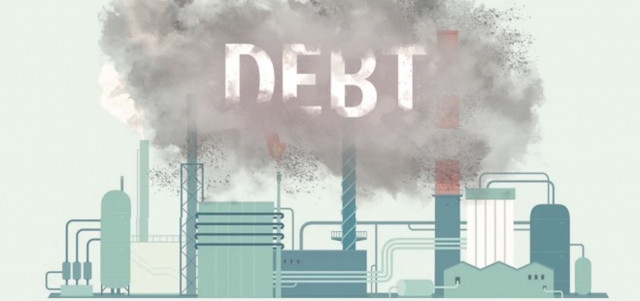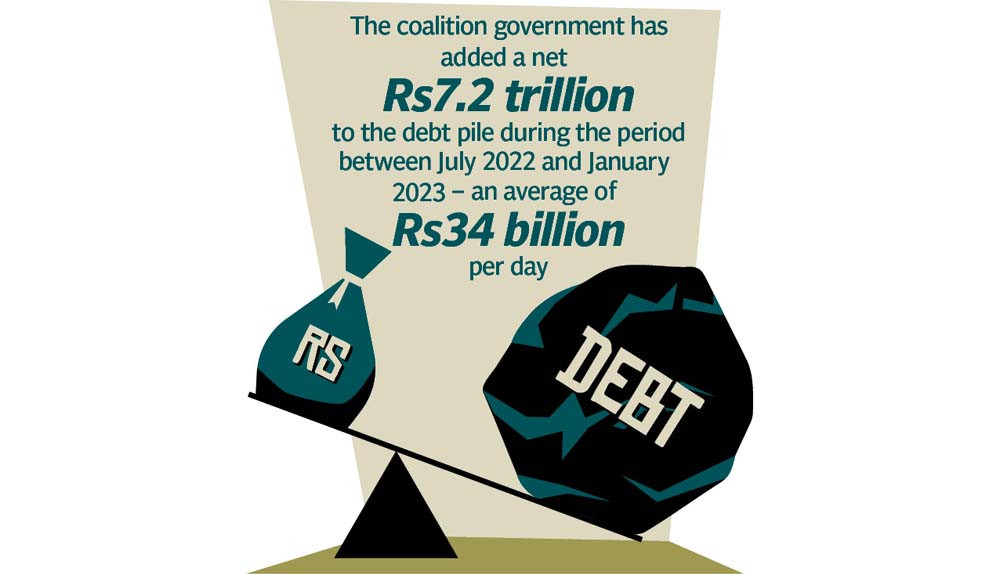Rs7.2tr added to debt from Jul-Jan
Reaches nearly Rs55 trillion, with debt burden increasing at the pace of 15%

The coalition government has managed to add a net Rs7.2 trillion to the debt pile in only the first seven months of this fiscal year – an average of Rs34 billion per day. The accumulation of debt is now nearly three times more than the gap between federal income and expenditures.
The State Bank of Pakistan (SBP) on Tuesday released the central government’s debt bulletin until January 2023, showing the adverse impact of the steep currency devaluation on debt.
Federal government’s debt increased to nearly Rs55 trillion as of end-January – a surge of Rs7.2 trillion from the period between July 2022 to January 2023, according to the SBP statement. The debt burden increased at a pace of 15% during this period, which for a country like Pakistan is entirely unsustainable.
The development came amidst disclosure that the net federal income dropped by Rs200 billion to Rs400 billion less than the total interest expenses. For the current fiscal year, the net federal income is estimated at Rs5 trillion while the cabinet last month approved a Rs5.2 trillion revised interest expenses bill for fiscal year 2022-23, ending in June.
This is the first time that the net income is even less than the cost of debt servicing. Now, the entire defence budget and civilian government expenses are being covered through fresh loans. The net income is calculated after payment of provincial shares in the federal taxes.
The Pakistan Democratic Movement (PDM) government has, on average, added Rs34 billion per day to the debt burden during this period. The increase, however, took place more due to currency devaluation than budget deficit financing.
According to the Finance Ministry, the federal budget deficit remained at Rs1.8 trillion in the first six months of the current fiscal year. There was no phenomenal increase in the deficit in January that widened at a normal average, according to the sources.
This is the first debt bulletin the central bank has released since the federal government allowed the rupee to depreciate on January 26th. The government took the decision to allow market forces to determine the value of the rupee to convince the International Monetary Fund (IMF) to release dates for their staff level visit.
The average exchange rate on the last day of fiscal year 2022 was Rs204.4 that depreciated by 31% in just seven months and closed at Rs267.9 to a dollar on January 31st, according to the central bank. The rupee is currently traded around Rs278 to a dollar.
This had a huge impact on the government’s external debt calculations, increasing at an alarming pace of 23.5% to Rs20.7 trillion within seven months. There was a net increase of Rs3.9 trillion in external debt, mainly because of currency depreciation.

In the last fiscal year, there was an increase of Rs9.4 trillion in public debt, a sum of Rs3.8 trillion, or 40.3%, caused by currency devaluation, according to the Debt Policy Statement released by the Ministry of Finance last month. The rupee depreciated by around 30% against the dollar during the last fiscal year, which increased external public debt when reported in Pakistani rupee terms.
Due to a combination of factors, including currency devaluation, public debt has remained above the statutory limit defined under the Fiscal Responsibility and Debt Limitation Act of 2005. The Finance Ministry’s report from last month showed that debt burden was higher by Rs10.4 trillion than the legally allowed limit, making it unsustainable.
The 58% limit, considered sustainable, was breached by 15.5% of the GDP or Rs10.4 trillion.
The currency risks of public debt have increased phenomenally, as the share of external debt in the total public debt is on the rise despite foreign financing lines drying up.
The SBP’s debt bulletin showed that domestic debt increased from Rs31 trillion in June last year to Rs34.3 trillion the end of January 2023. There was an increase of Rs3.2 trillion or 10.7% in domestic debt during the current fiscal year. While domestic debt is mostly raised for budget deficit financing, its quantum is still more than the total federal budget deficit.
Published in The Express Tribune, March 8th, 2023.
Like Business on Facebook, follow @TribuneBiz on Twitter to stay informed and join in the conversation.



1735506669-0/image-(16)1735506669-0-208x130.webp)















COMMENTS
Comments are moderated and generally will be posted if they are on-topic and not abusive.
For more information, please see our Comments FAQ